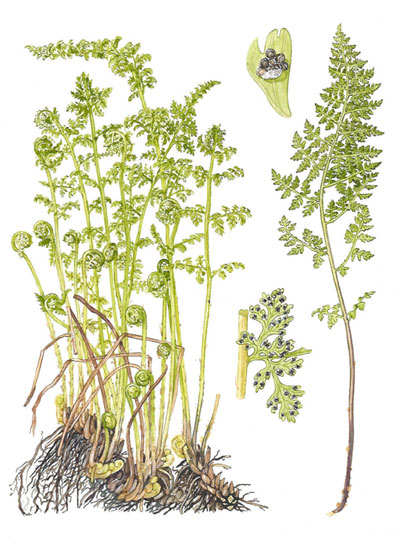|
Hardy Fern Home C. alpina resources
All Ferns � Woodsiaceae �� Cystopteris
�Other Genera
|
| Cystopteris alpina | ||
Alpine bladder fern | ||
|
Etymology
Alpina refers to the Alpine regions, i.e. above the timber line of high mountains.
Description
Rhizome: short-creeping, covered with old stipe bases, scales tan to light brown, lanceolate.
Frond: 40 cm high by 6 cm wide, deciduous, monomorphic, blade/stipe ratio: . Stipe: stipes --a few to several-- clustered at stem apex, grooved, dark at base, straw-colored to green above, sparsely scaly, vascular bundles: 2, round or oblong. Blade: 2-pinnate-pinnatifid, ovate-lanceolate, herbaceous, glabrous. Pinnae: 10 to 12 pair, lanceolate, widest just below the middle, at an angle to the rachis, leaning towards the tip, subopposite or alternate; pinnules narrow, wedge-shaped, more deeply cut; costae grooves above continuous from rachis to costae; margins lobed; veins free, simple or forked, ending at notches or at teeth on both sides of notches, forking only once or twice in the ultimate segment. Sori: round, in 1 row between midrib and margin, indusium: ovate to lanceolate, forming a hood over the sorus, but shriveling with maturity, beneath sorus on midrib side, sporangia: brown to black. Culture
Habitat: alpine areas, on calcareous substrate.
Distribution: Norway south to the Pyrenees, east to the Caucasus.
Hardy to -40�C, USDA Zone 2, requires a cool summer.
Distinctive Characteristics
Similar to C. fragilis, but frond more ovate, more deeply cut, the veins forking less in ultimate segments.
Synonyms
Cystopteris fragilis ssp. alpina (Lamarck) Hartman Polypodium regium L. Cystopteris regia of authors, not (L.) Desv Polypodium alpinum Lam. |
|
|
